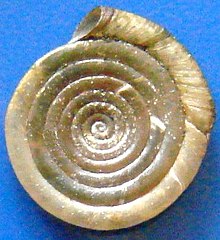Whorl (mollusc)



A whorl is a single, complete 360° revolution or turn in the
A spiral shell can be visualized as consisting of a long
The number of whorls which exist in an adult shell of a particular species depends on mathematical factors in the geometric growth, as described in
The number of whorls present in an adult shell differs greatly in various
The shells of a few genera of gastropods, and of the cephalopod genus Spirula, have whorls that are disconnected.
-
The shell of the marine gastropod Haliotis asinina has fewer than two whorls
-
The shell ofSpirula spirulahas disconnected whorls
Counting the number of whorls
To count exactly the number of whorls in gastropods a straight line is drawn to separate the semi-circular nucleus (protoconch (1 - see image) from the younger part of the shell.[1] An arrow placed at a 90° angle on this line, following the course of the whorl, reaches the end of the first whorl where it is parallel to its starting position.[1] From that point all whorls are counted towards the margin of the shell, estimating the ultimate whorl with an accuracy of a quarter whorl.[1]
Other authors (Ehrmann 1933;[2] Richter & Seapy 1999[3]) applied a slightly different measuring method, resulting in whorl numbers being a quarter higher.[1]
Terminology
- Apical whorls—the whorls near the apex or tip of the shell of gastropods
- Body whorl—The most recently formed whorl of a spiral shell, in which most of the body of the animal is found
- Nuclear whorl(s)—small, generally smooth whorls formed within the egg, and constituting the apex of the shell
- Protoconch—a larval shell of a mollusc; also refers to protoconch whorls of an adult shell
- Teleoconch—all the whorls of a shell after the protoconch whorls
- Nepionic whorls : the whorls immediately following the embryonic whorls.
References
This article incorporates CC-BY-3.0 text from the reference.[1]
Further reading
- Solem A. (1983) "Lost or kept internal whorls: ordinal differences in land snails". Journal of Molluscan Studies 49(supp. 12A): 172–178.





